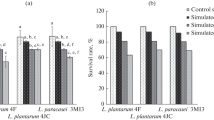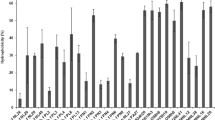Abstract
Demand for probiotics has increased significantly in recent years due to the growing consumer awareness of their benefits and advantages. In this study, we investigated the probiotic potential use of three antifungal lactic acid bacteria (LAB) strains namely Lactiplantibacillus pentosus 22B, Lactiplantibacillus plantarum 21B and Enterococcus faecium LC2V5 isolated from wheat and camel milk. A series of in vitro probiotic tests were performed to evaluate their functional and safety properties. Results indicated that consumption of these three strains does not present any health risk, as they showed no undesirable virulence factors (hemolysins and DNAse) or transmissible antibiotic resistance. All strains exhibited high tolerance to simulated oro-gastro-intestinal tract conditions since the number of viable cells was 109 CFU/mL after exposure to these digestive stress environments. Evaluation of cell surface characteristics revealed that the three strains showed high degrees of auto-aggregation, hydrophobicity and co-aggregation with pathogens. Moreover, the strains demonstrated strong antagonistic activity against all tested pathogenic bacteria (Salmonella typhimurium, Listeria monocytogenes, Klebsiella pneumoniae, Escherichia coli, Acinetobacter baumannii and Pseudomonas aeruginosa). Furthermore, they were able to produce exopolysaccharides and ferment lactose. The studied strains showed also antioxidant activity by scavenging 1,1-diphenyl-2-picrylhydrazyl (DPPH) free radicals. In conclusion, the probiotic features demonstrated by the studied LAB strains suggest their suitability for potential use as probiotics.





Similar content being viewed by others
Abbreviations
- LAB:
-
Lactic acid bacteria
- CFU:
-
Colony forming unit
- DPPH:
-
1,1-diphenyl-2-picrylhydrazyl)
- FAO:
-
Food and Agriculture Organization of the United Nations
- WHO:
-
World Health Organization
- MRS agar:
-
De Man, Rogosa and Sharpe agar
- PBS:
-
Phosphate-Buffered Saline
- OD:
-
Optical density
- E 15:
-
15 μg Erythromycin
- TE 30:
-
30 μg Tetracycline
- AMP 10:
-
10 μg Ampicillin
- S 25:
-
25 μg Streptomycin
- FOS 50:
-
50 μg Fosfomycin
- IPM 10:
-
10 μg Imipenem
- KF 30:
-
30 μg Cephalothin
- K 30:
-
30 μg Kanamycin
- CN 10:
-
10 μg Gentamicin
- SXT 25:
-
25 μg Trimethoprim/Sulfamethoxazole
- SAM 20:
-
20 μg Ampicillin/Sulbactam
- EPS:
-
Exopolysaccharides
References
Abouloifa H, Rokni Y, Bellaouchi R et al (2019) Characterization of probiotic properties of antifungal Lactobacillus strains isolated from traditional fermenting green olives. Probiotics Antimicrob Proteins 12:683–696. https://doi.org/10.1007/s12602-019-09543-8
Abushelaibi A, Al-Mahadin S, El-Tarabily K et al (2017) Characterization of potential probiotic lactic acid bacteria isolated from camel milk. LWT - Food Sci Technol 79:316–325. https://doi.org/10.1016/j.lwt.2017.01.041
Angmo K, Kumari A, Savitri BTC (2016) Probiotic characterization of lactic acid bacteria isolated from fermented foods and beverage of Ladakh. LWT - Food Sci Technol 66:428–435. https://doi.org/10.1016/j.lwt.2015.10.057
Bazireh H, Shariati P, Azimzadeh Jamalkandi S et al (2020) Isolation of novel probiotic Lactobacillus and Enterococcus strains from human salivary and fecal sources. Front Microbiol 11:1–12. https://doi.org/10.3389/fmicb.2020.597946
Binda S, Hill C, Johansen E et al (2020) Criteria to qualify microorganisms as “probiotic” in foods and dietary supplements. Front Microbiol 11:1–9. https://doi.org/10.3389/fmicb.2020.01662
Bove P, Gallone A, Russo P et al (2012) Probiotic features of Lactobacillus plantarum mutant strains. Appl Microbiol Biotechnol 96:431–441. https://doi.org/10.1007/s00253-012-4031-2
CA-SFM / EUCAST. Comité de l’antibiogramme de la Société Française de Microbiologie. Recommandations 2020. https://www.sfm-microbiologie.org/wp-content/uploads/2020/04/CASFM2020_Avril2020_V1.1.pdf. Accessed 20 April 2022
Collado MC, Surono I, Meriluoto J, Salminen S (2007) Indigenous dadih lactic acid bacteria: cell-surface properties and interactions with pathogens. J Food Sci 72:89–93. https://doi.org/10.1111/j.1750-3841.2007.00294.x
Corcoran BM, Stanton C, Fitzgerald GF, Ross RP (2005) Survival of probiotic lactobacilli in acidic environments is enhanced in the presence of metabolizable sugars. Appl Environ Microbiol 71:3060–3067. https://doi.org/10.1128/AEM.71.6.3060-3067.2005
Daba GM, El-Dien AN, Saleh SAA et al (2021) Evaluation of Enterococcus strains newly isolated from Egyptian sources for bacteriocin production and probiotic potential. Biocatal Agric Biotechnol 35:102058. https://doi.org/10.1016/j.bcab.2021.102058
Damodharan K, Lee YS, Palaniyandi SA (2015) Preliminary probiotic and technological characterization of Pediococcus pentosaceus strain KID7 and in vivo assessment of its cholesterol-lowering activity 6:1–14. https://doi.org/10.3389/fmicb.2015.00768
Das DJ, Shankar A, Johnson JB, Thomas S (2020) Critical insights into antibiotic resistance transferability in probiotic Lactobacillus. Nutrition 69:110567. https://doi.org/10.1016/j.nut.2019.110567
de Melo Pereira GV, de Oliveira CB, Magalhães Júnior AI et al (2018) How to select a probiotic? A review and update of methods and criteria. Biotechnol Adv 36:2060–2076. https://doi.org/10.1016/j.biotechadv.2018.09.003
Divya JB, Varsha KK, Nampoothiri KM (2012) Newly isolated lactic acid bacteria with probiotic features for potential application in food industry. Appl Biochem Biotechnol 167:1314–1324. https://doi.org/10.1007/s12010-012-9561-7
Espeche MC, Pellegrino M, Frola I et al (2012) Lactic acid bacteria from raw milk as potentially beneficial strains to prevent bovine mastitis. Anaerobe 18:103–109. https://doi.org/10.1016/j.anaerobe.2012.01.002
FAO/WHO (2006) Probiotics in food. Health and nutritional properties and guidelines for evaluation. FAO Food Nutr Pap 85:2
Feng T, Wang J (2020) Oxidative stress tolerance and antioxidant capacity of lactic acid bacteria as probiotic: a systematic review. Gut Microbes 12:1–24. https://doi.org/10.1080/19490976.2020.1801944
Fguiri I, Ziadi M, Atigui M (2016) Isolation and characterisation of lactic acid bacteria strains from raw camel milk for potential use in the production of fermented Tunisian dairy products. Int J Dairy Technol 69:103–113. https://doi.org/10.1111/1471-0307.12226
George Kerry R, Patra JK, Gouda S et al (2018) Benefaction of probiotics for human health: a review. J Food Drug Anal 26:927–939. https://doi.org/10.1016/j.jfda.2018.01.002
Górska A, Przystupski D, Niemczura MJ, Kulbacka J (2019) Probiotic Bacteria: a promising tool in Cancer prevention and therapy. Curr Microbiol 76:939–949. https://doi.org/10.1007/s00284-019-01679-8
Grujović MŽ, Mladenović KG, Nikodijević DD, Čomić LR (2019) Autochthonous lactic acid bacteria—presentation of potential probiotics application. Biotechnol Lett 41:1319–1331. https://doi.org/10.1007/s10529-019-02729-8
Hernández-Gómez JG, López-Bonilla A, Trejo-Tapia G et al (2021) In vitro bile salt hydrolase (Bsh) activity screening of different probiotic microorganisms. Foods 10:1–10. https://doi.org/10.3390/foods10030674
Jones ML, Tomaro-Duchesneau C, Martoni CJ, Prakash S (2013) Cholesterol lowering with bile salt hydrolase-active probiotic bacteria, mechanism of action, clinical evidence, and future direction for heart health applications. Expert Opin Biol Ther 13:631–642. https://doi.org/10.1517/14712598.2013.758706
Kim H, Kim JS, Kim YG et al (2020) Antioxidant and probiotic properties of Lactobacilli and Bifidobacteria of human origins. Biotechnol Bioprocess Eng 25:421–430. https://doi.org/10.1007/s12257-020-0147-x
Lakhlifi T, Es-sbata I, Eloirdi S et al (2021) Biopreservation of yogurt against fungal spoilage using cell-free supernatant of Lactiplantibacillus pentosus 22B and characterization of its antifungal compounds. Food Biotechnol 35:327–348. https://doi.org/10.1080/08905436.2021.1980004
Li S, Zhao Y, Zhang L et al (2012) Antioxidant activity of Lactobacillus plantarum strains isolated from traditional Chinese fermented foods. Food Chem 135:1914–1919. https://doi.org/10.1016/j.foodchem.2012.06.048
Li T, Teng D, Mao R et al (2020) A critical review of antibiotic resistance in probiotic bacteria. Food Res Int 136:109571. https://doi.org/10.1016/j.foodres.2020.109571
Liu J, Chan SHJ, Chen J et al (2019) Systems biology - a guide for understanding and developing improved strains of lactic acid bacteria. Front Microbiol 10:1–19. https://doi.org/10.3389/fmicb.2019.00876
Maldonado Galdeano C, Cazorla SI, Lemme Dumit JM et al (2019) Beneficial effects of probiotic consumption on the immune system. Ann Nutr Metab 74:115–124. https://doi.org/10.1159/000496426
Marco ML, Sanders ME, Gänzle M et al (2021) The international scientific Association for Probiotics and Prebiotics (ISAPP) consensus statement on fermented foods. Nat Rev Gastroenterol Hepatol 18:196–208. https://doi.org/10.1038/s41575-020-00390-5
Margalho LP, Jorge GP, Noleto DAP et al (2021) Biopreservation and probiotic potential of a large set of lactic acid bacteria isolated from Brazilian artisanal cheeses: from screening to in product approach. Microbiol Res 242. https://doi.org/10.1016/j.micres.2020.126622
Mathur S, Singh R (2005) Antibiotic resistance in food lactic acid bacteria—a review. Int J Food Microbiol 105:281–295. https://doi.org/10.1016/j.ijfoodmicro.2005.03.008
Minelli EB, Benini A (2008) Relationship between number of bacteria and their probiotic effects. Microb Ecol Health Dis 20:180–183. https://doi.org/10.1080/08910600802408095
Nakagawa H, Miyazaki T (2017) Beneficial effects of antioxidative lactic acid bacteria. AIMS Microbiol 3:1–7. https://doi.org/10.3934/microbiol.2017.1.1
Oak SJ, Jha R (2019) The effects of probiotics in lactose intolerance: a systematic review. Crit Rev Food Sci Nutr 59:1675–1683. https://doi.org/10.1080/10408398.2018.1425977
Oh YJ, Jung DS (2015) Evaluation of probiotic properties of Lactobacillus and Pediococcus strains isolated from Omegisool, a traditionally fermented milletalcoholic beverage in Korea. LWT - Food Sci Technol 63:437–444. https://doi.org/10.1016/j.lwt.2015.03.005
Oliver WT, Wells JE (2015) Lysozyme as an alternative to growth promoting antibiotics in swine production. J Anim Sci Biotechnol 6:1–7. https://doi.org/10.1186/s40104-015-0034-z
Pino A, Bartolo E, Caggia C et al (2019) Detection of vaginal lactobacilli as probiotic candidates. Sci Rep 9:1–10. https://doi.org/10.1038/s41598-019-40304-3
Reis JA, Paula AT, Casarotti SN, Penna ALB (2012) Lactic acid Bacteria antimicrobial compounds: characteristics and applications. Food Eng Rev 4:124–140. https://doi.org/10.1007/s12393-012-9051-2
Reissig Soares Vitola H, da Silva DG, de Lima MJ et al (2018) Probiotic potential of Lactobacillus casei CSL3 isolated from bovine colostrum silage and its viability capacity immobilized in soybean. Process Biochem 75:22–30. https://doi.org/10.1016/j.procbio.2018.09.011
Reuben RC, Roy PC, Sarkar SL et al (2020) Characterization and evaluation of lactic acid bacteria from indigenous raw milk for potential probiotic properties. J Dairy Sci 103:1223–1237. https://doi.org/10.3168/jds.2019-17092
Shokryazdan P, Faseleh Jahromi M, Liang JB, Ho YW (2017) Probiotics: from isolation to application. J Am Coll Nutr 36:666–676. https://doi.org/10.1080/07315724.2017.1337529
Stoyanova LG, Ustyugova EA, Netrusov AI (2012) Antibacterial metabolites of lactic acid bacteria: their diversity and properties. Appl Biochem Microbiol 48:229–243. https://doi.org/10.1134/S0003683812030143
Taroub B, Salma L, Manel Z et al (2019) Isolation of lactic acid bacteria from grape fruit: antifungal activities, probiotic properties, and in vitro detoxification of ochratoxin A. Ann Microbiol 69:17–27. https://doi.org/10.1007/s13213-018-1359-6
Thushara RM, Gangadaran S, Solati Z, Moghadasian MH (2016) Cardiovascular benefits of probiotics: a review of experimental and clinical studies. Food Funct 7:632–642. https://doi.org/10.1039/c5fo01190f
Zhou Y, Cui Y, Qu X (2019) Exopolysaccharides of lactic acid bacteria: structure, bioactivity and associations: a review. Carbohydr Polym 207:317–332. https://doi.org/10.1016/j.carbpol.2018.11.093
Zommiti M, Cambronel M, Maillot O et al (2018) Evaluation of probiotic properties and safety of Enterococcus faecium isolated from artisanal Tunisian meat “Dried Ossban”. Front Microbiol 9:1–12. https://doi.org/10.3389/fmicb.2018.01685
Žugić Petrović TD, Ilić PD, Grujović MŽ et al (2020) Assessment of safety aspect and probiotic potential of autochthonous Enterococcus faecium strains isolated from spontaneous fermented sausage. Biotechnol Lett 42:1513–1525. https://doi.org/10.1007/s10529-020-02874-5
Funding
This study was supported by “Centre National pour la Recherche Scientifique et Technique” under Grant Agreement No [PPR2/2016/07].
Author information
Authors and Affiliations
Contributions
The authors confirm contributions to the paper as follows: Study conception and design: Tarik Lakhlifi; Material preparation and analysis: Tarik Lakhlifi and Samia El oirdi; Writing - original draft preparation: Tarik Lakhlifi; Writing - review and editing: Abdelhaq Belhaj, Itto Maroui, Rachid Zouhair; Supervision: Abdelhaq Belhaj. All authors read and approved the final manuscript.
Corresponding author
Ethics declarations
Research involving human participants and/or animals
This article does not contain any studies with human participants or animals performed by any of the authors.
Competing interests
The authors have no relevant financial or non-financial interests to disclose.
Conflict of interest
On behalf of all authors, the corresponding author states that there is no conflict of interest.
Additional information
Publisher’s note
Springer Nature remains neutral with regard to jurisdictional claims in published maps and institutional affiliations.
Rights and permissions
Springer Nature or its licensor (e.g. a society or other partner) holds exclusive rights to this article under a publishing agreement with the author(s) or other rightsholder(s); author self-archiving of the accepted manuscript version of this article is solely governed by the terms of such publishing agreement and applicable law.
About this article
Cite this article
Lakhlifi, T., El oirdi, S., Maroui, I. et al. Probiotic properties and safety aspect of three antifungal lactic acid bacteria strains isolated from wheat and camel milk. Biologia 78, 1129–1139 (2023). https://doi.org/10.1007/s11756-023-01319-4
Received:
Accepted:
Published:
Issue Date:
DOI: https://doi.org/10.1007/s11756-023-01319-4




